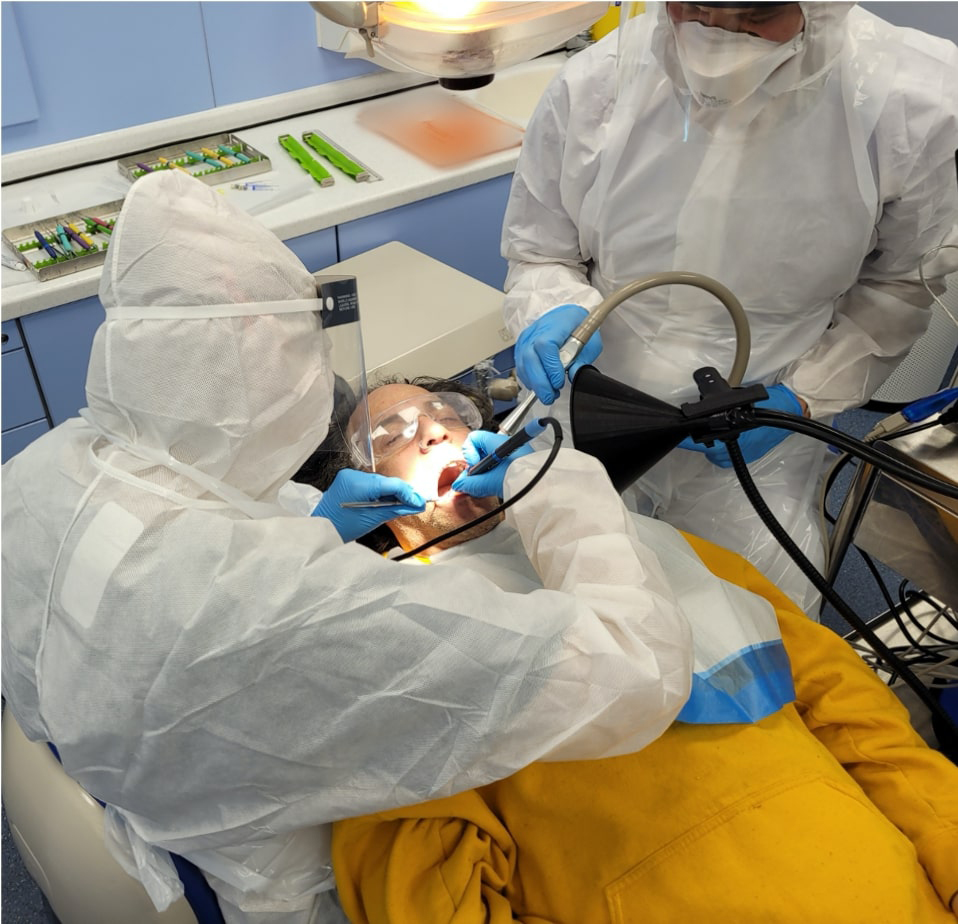Dental procedures are very low risk in the aerosol spread of COVID-19, University of Bristol study finds

Please note this is a preprint, it is a preliminary piece of research that has not yet been through peer review and has not been published in a scientific journal – so this is early data.
Many of the common procedures carried out by dentists have very low risk of increasing the aerosol spread of COVID-19 and some procedures, such as ultrasonic scaling, were not shown to generate aerosol other than from the clean instrument itself, new research has found.
The National Institute for Health Research (NIHR) and UK Research and Innovation (UKRI)-funded study by the University of Bristol, University Hospitals Bristol and Weston NHS Foundation Trust (UHBW) and North Bristol NHS Trust (NBT) is the largest to date to specifically measure aerosol generation from dental instruments in real-patient clinical scenarios. The paper is published on the preprint server medRxiv.
COVID-19 has required additional precautions in dental practices to protect patients and staff, including the use of FFP3 masks and extra time between patients to allow aerosol to disperse. These measures only apply to dental aerosol generating procedures and have led to a dramatic reduction in dental services. Several studies have already demonstrated that aerosols are produced in simulated studies on dental dummies. However, it is not clear which dental procedures generate aerosol and, if they do, whether the aerosol could potentially carry the SARS-CoV-2 virus.
The research, part of the AERosolisation And Transmission Of SARS-CoV-2 in Healthcare Settings (AERATOR) study, set out to measure the amount of aerosol produced from a wide range of dental procedures carried out on patients. Where aerosol was detected in patient procedures, the research team compared the size distributions of this aerosol to the aerosol produced from the dental instrument itself when used in a (non-patient) phantom head control.
The study found the ultrasonic instrument, commonly used for dental scaling, produced much lower aerosol concentrations than the high-speed dental drill despite the two instruments currently requiring the same precautions. Also, aerosol produced during the ultrasonic scaling procedure was consistent with the clean aerosol produced from the instrument itself and did not show additional aerosol is produced that could potentially spread COVID-19.
Tom Dudding, Restorative Dentistry Specialty Trainee in the Bristol Dental School at the University of Bristol and joint first author of the study, said: “Our study confirms much of the guidance around dental procedures deemed as low risk of spreading COVID-19 is correct, but suggests that the ultrasonic instrument could be seen as lower risk than it currently is.
“Our findings could allow the expansion of dental, hygiene and therapy work as it would reduce the need for additional precautions such as additional personal protective equipment (PPE) and fallow times when using this instrument.”
Mark Gormley, Consultant Senior Lecturer in the Bristol Dental School and joint senior author of the study, added: “Our study provides strong evidence to confirm many of the common dental procedures have very low risk of increasing the aerosol spread of COVID-19. We also found that some other procedures, such as ultrasonic scaling, do not appear to generate additional aerosol above that of the instrument itself and do not increase the risk to dentists, relative to the risk of being near the patient.”
For procedures such as the high- and slow- speed drilling commonly used for dental fillings, crown preparations and polishing, the next step for the research team would be to repeat these experiments with instruments which can further differentiate between aerosol produced by the dental instrument and aerosol which has been contaminated by bodily fluids, such as saliva. If no contaminated aerosol is identified, these instruments would also be safe for use without additional precautions.
The researchers will also consider conducting a non-inferiority, randomised controlled trial of additional precautions (PPE and fallow time) versus pre-COVID-19 precautions in dental practices. The study would look at the difference in infection rates in patients and dental staff across the two groups with no difference demonstrating the additional precautions are not needed.
Paper
‘A clinical observational analysis of aerosol emissions from dental procedures’ by T. Dudding, S. Sheikh, M Gormley , AERATOR group et al in medRxiv
